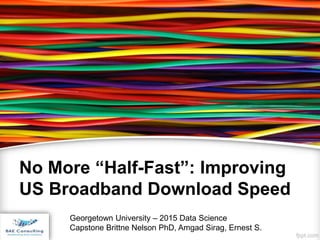No More Half Fast: Improving US Broadband Download Speed. Georgetown University Data Science Capstone
- 1. No More “Half-Fast”: Improving US Broadband Download Speed Georgetown University – 2015 Data Science Capstone Brittne Nelson PhD, Amgad Sirag, Ernest S.
- 2. Approach and Overview What? • Broadband Data Story • Research Problem • Data Science Pipeline So What? • Data Visualization Story • Findings • Lessons Learned Now What? • Future Research • Conclusions
- 3. WHAT?
- 4. There were communities with no broadband access Every day, residents and businesses had limited or no access to resources, services, content, new customers, and new technology limiting opportunities and community empowerment One day, the US government created the SBI to facilitate the integration of broadband and information technology into state and local economies Because of that, states did more to quickly expand broadband to more areas Because of that, the SBI, decision makers, and researchers- including us- were able to assess how broadband is being implemented across the US Until finally, residents and businesses gained more access to resources services, content, new customers, and technology that empowered and gave them a competitive edge Data Story
- 5. Benefits of Broadband • Increased job opportunities • Increased employment opportunities due to telework • Higher pay • Increased economic security • Recruitment of job seekers, especially in rural areas • Increased access to and quality of healthcare • Availability of a wide variety of entertainment • Increased participation in everyday economic, social, and community life • Improved social connections to existing friends and acquaintances • Creation of new relationships based on common interests • Improved social integration of minority populations • More positive attitudes toward aging • Higher levels of perceived social support and connectivity among seniors • Lower prices for online purchases • Improved variety of items available for purchase • Better purchasing decisions based on online information • Savings in time and money for online vs. paper-based activities • Improved connectivity for social or political action Sources: Center for Social Inclusion,. (2010). The Promise and Challenge of Community Broadband Models. New York City: Center for Social Inclusion. Analytics ASR,. (2014). Final Report: Social and Economic Impacts of the Broadband Technology Opportunities Program. Potomac Maryland.
- 6. Research Problem • Does broadband availability and speed make a state’s economy and it’s residents competitive? • When will every state reach 98% broadband connectivity? • How are community economic features impacting or related to broadband development?
- 7. Hypotheses • Broadband speed and accessibility will cluster in urban areas • Areas with more broadband speed will have lower unemployment, more businesses, and larger populations • Broadband growth is not consistent across all counties • Based on past growth, broadband coverage is not expected to be available in 98% of all counties in 2016
- 8. Data Sources • National Broadband Map Maximum and Minimum Download Speed by County, June 2011-June 2014 – National Telecommunications and Information Administration http://www.broadbandmap.gov/data-download • Labor Force Data by County Annual Average, 2011-2013 – U.S. Department of Labor Local Area Unemployment Statistics http://www.bls.gov/lau/ • Demographic Population by County, 2010 – U.S Census Bureau http://factfinder.census.gov/faces/nav/jsf/pages/index.xhtml • Total Number of Business Establishments, 2011-2012 – U.S Census Bureau http://factfinder.census.gov/faces/nav/jsf/pages/index.xhtml
- 9. Resources
- 10. Data Science Pipeline Sources: Ojeda, T., Murphy, S., Bengfort, B., & Dasgupta, A. (2014). Practical data science cookbook. Birmingham: Packt Publishing.
- 11. SO WHAT?
- 12. Switch to Tableau Data Visualization
- 13. Hypotheses Results • Broadband speed and accessibility will cluster in urban areas • “URBAN” TOO DIFFICULT TO DEFINE GIVEN PROJECT TIMELINE, NOT ANALYZED • Areas with higher broadband speed have lower unemployment, more businesses, and larger populations • NOT TRUE • Broadband growth is not consistent across all counties • TRUE • Based on past growth, broadband coverage is not expected to be available in 98% of all counties in 2016 • NOT ENOUGH DATA TO COMFORTABLY FORECAST
- 14. Summary of Findings • Identified economic features are mild drivers of technology implementation specifically broadband speed. • Broadband availability makes a state economy and it’s residents competitive. • Implementing broadband is not the silver bullet to community development or economic growth, it should be incorporated with other economic and social features.
- 15. Lessons Learned • Quantity of data is important for forecasting • Source of data is important. SBI reports data from providers which makes it somewhat difficult to assess • Plan a significant amount of time for data wrangling • Master each step of the data science pipeline before moving on • Operationalize more factors to provide a clear picture of relationships when identifying hypotheses
- 16. NOW WHAT?
- 17. Future Research • Develop a matched pairs analysis framework that compares changes in the availability of broadband at the state level between counties • Measure how much of the growth in availability within these counties occurred due to funding (Grants, Federal Government, Private Organizations) • Examine broadband’s long-term quantitative extrapolations and impact on social and economics • Index and model additional community factors such as education, adoption, tax rate, etc in order to broadly define economic impact
- 18. Conclusions • There is a business case for continued focus on broadband improvement • Broadband improves the overall communities • Drives economic development and shared opportunities • Improve quality of life across the United States
- 19. Thank You to the Georgetown University 2015 Data Science Program Faculty Benjamin Bengfort Allen Leis Sacha Litman Laura Lorenz Salil Mehta Tony Ojeda (and lady!)
- 20. Questions?


























